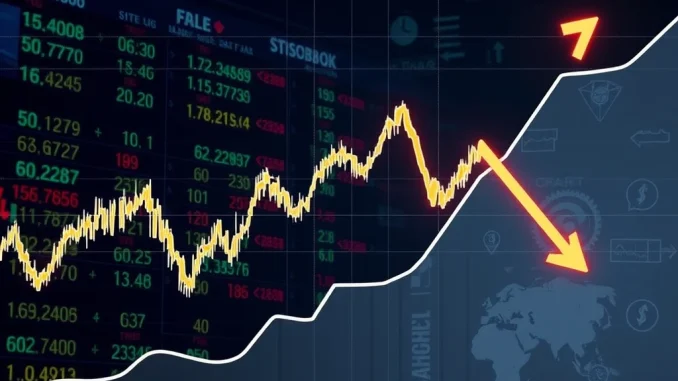
Is the crypto bull run taking an unexpected breather? Recent analysis from Amberdata suggests that the vibrant crypto market might be bracing for a period of market weakness. Amidst swirling concerns in traditional finance, including a concerning bond slump and escalating global trade tensions, the digital asset space could be feeling the chill. Let’s dive into what’s fueling this cautious outlook and what it means for your crypto portfolio.
Why Crypto Market Weakness Could Persist?
According to Mike Marshall, head of research at Amberdata, the current turbulence in traditional financial markets is casting a shadow over the crypto sphere. His analysis, highlighted in a report by The Block, points towards a confluence of factors that could prolong the current phase of crypto market weakness. These aren’t just isolated crypto-specific issues; they’re deeply intertwined with broader economic uncertainties. Let’s break down the key concerns:
- Traditional Finance Instability: Marshall emphasizes that instability in traditional finance is a significant headwind for crypto. When traditional markets waver, it often triggers a risk-off sentiment across the board, impacting even the seemingly uncorrelated crypto assets.
- U.S. Treasury Weakness: The performance of U.S. Treasuries is a crucial indicator. Weakness in this sector can signal broader economic anxieties, prompting investors to seek safer havens and potentially pulling capital away from riskier assets like cryptocurrencies.
- Trade Tensions Remain High: While there was a temporary pause in tariff escalations, the underlying trade tensions, particularly between the U.S. and China, are far from resolved. Marshall suggests that the market’s optimistic reaction to the 90-day tariff pause might be premature, as existing tariffs remain elevated and continue to exert economic pressure.
In essence, Marshall’s analysis suggests that the crypto market isn’t operating in a vacuum. It’s intrinsically linked to the health and sentiment of the global financial system. And right now, the signals from traditional finance are flashing caution.
The Looming Bond Slump: A Red Flag for Crypto?
One of the critical points highlighted by Amberdata is the bond slump, specifically in U.S. Treasuries. But what exactly does a bond slump mean, and how does it relate to the crypto market? Let’s unpack this:
Understanding Bond Slumps
A bond slump typically refers to a period where bond prices are falling, and yields are rising. This can happen for various reasons, including:
- Rising Inflation Expectations: If investors anticipate higher inflation, they demand higher yields on bonds to compensate for the erosion of purchasing power. This pushes bond prices down.
- Anticipation of Interest Rate Hikes: Central banks raising interest rates can make newly issued bonds more attractive, leading to a decrease in demand for older, lower-yielding bonds, thus causing a bond slump.
- Economic Uncertainty: Paradoxically, sometimes a bond slump can occur amidst economic uncertainty. If investors fear increased government borrowing or a credit downgrade, they might sell bonds, driving prices down and yields up.
The Crypto Connection
So, how does a bond slump translate into potential crypto market weakness?
- Risk-Off Sentiment: A bond slump can be a symptom of broader unease in the financial markets. It can trigger a “risk-off” sentiment, where investors become more risk-averse and seek safer assets. Cryptocurrencies, often perceived as higher-risk assets, can be negatively impacted in such environments.
- Increased Borrowing Costs: Rising bond yields generally translate to higher borrowing costs across the economy. This can dampen economic activity and potentially reduce the flow of capital into riskier investments like crypto.
- Opportunity Cost: As bond yields rise, they become more attractive relative to other investments. Investors might find the perceived “safe haven” of higher-yielding bonds more appealing compared to the volatility of the crypto market, leading to a shift in investment allocation.
Therefore, the bond slump isn’t just an isolated event in the fixed income market; it can act as a barometer for broader financial stress and influence investor behavior in the crypto space.
Trade Tensions: The Unseen Pressure on Crypto?
The global economic landscape is currently navigating a complex web of trade tensions, particularly the ongoing dynamic between the United States and China. While headlines often focus on tariffs and trade deals, the undercurrent of these trade tensions can exert a subtle yet significant pressure on the crypto market. Let’s explore how:
Beyond Tariffs: The Broader Impact of Trade Tensions
It’s crucial to understand that trade tensions are about more than just tariffs. They encompass a range of factors that can influence economic sentiment and market behavior:
- Supply Chain Disruptions: Trade tensions can disrupt global supply chains, leading to increased costs for businesses and potentially impacting economic growth.
- Currency Fluctuations: Uncertainty surrounding trade can lead to volatility in currency markets, impacting the value of assets across different regions.
- Geopolitical Uncertainty: Trade tensions are often intertwined with broader geopolitical risks, creating an environment of uncertainty that can make investors more cautious.
- Impact on Global Growth: Escalating trade tensions can dampen global economic growth forecasts, leading to a more risk-averse investment climate.
Crypto’s Exposure to Trade Tensions
While crypto is often touted as being decentralized and independent, it’s not immune to the ripple effects of global trade tensions:
- Market Sentiment: Trade tensions contribute to overall market uncertainty and can negatively impact investor sentiment. This can lead to a decrease in risk appetite, affecting crypto alongside other asset classes.
- Economic Slowdown Concerns: If trade tensions lead to a global economic slowdown, it could reduce disposable income and investment capital available for crypto.
- Potential for Safe Haven Demand: Conversely, in times of extreme economic uncertainty fueled by trade tensions, some investors might seek refuge in assets perceived as alternatives to traditional systems, potentially including certain cryptocurrencies like Bitcoin. However, this “safe haven” narrative for crypto is still evolving and not universally accepted.
Therefore, while the direct link between trade tensions and crypto prices might not always be immediately apparent, the broader economic uncertainty and risk aversion they generate can contribute to periods of crypto market weakness.
Navigating Market Instability: Crypto Analysis is Key
In times of market instability, like the current environment highlighted by Amberdata’s crypto analysis, staying informed and adopting a strategic approach is paramount. So, what actionable steps can you take to navigate these uncertain waters?
Actionable Insights for Crypto Investors
Here are some key strategies to consider during periods of potential market instability:
- Stay Informed with Crypto Analysis: Regularly follow reputable sources of crypto analysis like Amberdata and other market intelligence platforms. Understanding expert perspectives can help you make more informed decisions.
- Diversification is Your Friend: Don’t put all your eggs in one basket. Diversify your crypto portfolio across different types of assets and consider maintaining a balance between crypto and traditional investments.
- Risk Management is Crucial: Define your risk tolerance and adjust your portfolio accordingly. Consider using stop-loss orders and other risk management tools to protect your capital.
- Long-Term Perspective: Remember that crypto markets are inherently volatile. Focus on the long-term potential of your chosen projects and avoid making impulsive decisions based on short-term market fluctuations.
- Dollar-Cost Averaging (DCA): Consider using DCA to gradually build your positions over time, rather than trying to time the market. This can help mitigate the impact of volatility.
- Due Diligence is Essential: Before investing in any crypto asset, conduct thorough research and understand the project’s fundamentals, technology, and team.
Conclusion: Prepare, Don’t Panic in the Face of Potential Crypto Market Weakness
Amberdata’s warning serves as a crucial reminder that the crypto market, while dynamic and innovative, is not immune to the ebbs and flows of the global financial system. The potential for crypto market weakness, fueled by bond market jitters and persistent trade tensions, underscores the need for caution and informed decision-making.
Instead of panicking, view this as an opportunity to refine your investment strategy, deepen your understanding of crypto analysis, and prepare for potential market fluctuations. By staying informed, managing risk effectively, and maintaining a long-term perspective, you can navigate these uncertain times and position yourself for future opportunities in the ever-evolving world of cryptocurrency. The key is to be prepared, not scared.



